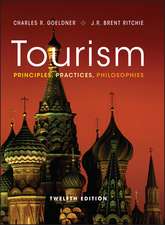The Making of American Resorts: Saratoga Springs, Ballston Spa, and Lake George
Autor Theodore Corbetten Limba Engleză Paperback – 2001
What factors create a successful resort? How did the rise of lavish hotels and spas reflect the changing values of American society as the nineteenth century progressed? Historians have argued that resorts were created to meet the demands of a leisured social elite. Theodore Corbett offers a fresh, compelling argument, demonstrating that resorts created and re-created themselves to keep pace with changing times. Success came with anticipating demands, not just reacting to them.
Using an impressive variety of historical documents, Corbett focuses on the conditions underlying the rise—and the demise—of the resorts at Ballston Spa and Caldwell on Lake George. Both towns’ major landlord–developers saw tourism as only one vehicle that could lead to success. As a result of their divided policies, neither town invested in the proper infrastructure to make tourism an immediate succes. Both places were soon overshadowed by Saratoga Springs, which became the premier resort of the upper and middle class.
Due to complex interwoven influences, Saratoga Springs was able to supply the amenities needed to attract and retain the patronage of the well heeled. The town provided visitors with lavish hotels, parks, public squares, pleasure gardens, and convenient service alleys. Saratoga Springs also had a work force that was available for the five-month period per year that the spas were active. Corbett examines the history and participation of various ethnic groups in the resort’s service sector: African Americans, Irish, and Native Americans.
Corbett also stresses middle-class America’s emulation of the leisure habits of the English aristocracy. Even though these pursuits (hunting, fishing, horse racrting) were dominaterd by men, social rituals were dominated by women, and resorts that accommodated “public domesticity” thrived as the century progressed. The Making of American Resorts offers a window into shifting public values and the structure of commercial tourism.
Preț: 341.00 lei
Nou
Puncte Express: 512
Preț estimativ în valută:
65.26€ • 67.88$ • 53.87£
65.26€ • 67.88$ • 53.87£
Carte tipărită la comandă
Livrare economică 14-28 aprilie
Preluare comenzi: 021 569.72.76
Specificații
ISBN-13: 9780813528427
ISBN-10: 0813528429
Pagini: 312
Ilustrații: 1
Dimensiuni: 178 x 254 x 18 mm
Greutate: 0.65 kg
Ediția:None
Editura: Rutgers University Press
Colecția Rutgers University Press
ISBN-10: 0813528429
Pagini: 312
Ilustrații: 1
Dimensiuni: 178 x 254 x 18 mm
Greutate: 0.65 kg
Ediția:None
Editura: Rutgers University Press
Colecția Rutgers University Press
Notă biografică
Theodore Corbett is a historian and member of the St. Augustine Historical Society. He has been previously published by Rutgers University Press and University of Oklahoma Press
Cuprins
List of Illustrations
List of Tables
Preface
Acknowledgments
Introduction: The Creation of Resorts
Part One. Early Resorts
1. The Tradition of the English Spa
2. The Rise and Fall of Ballston Spa as a Resort
3. The Reluctant Resort: Caldwell on Lake George
Part Two. The Establishment of Saratoga Springs as the Leading Resort
4. The Development of Public Spaces
5. Accommodations: Private Spaces for the Public
6. Alleys as Support Spaces
Part Three. The Resort Workforce
7. The Building Trades
8. The African American Presence
9. The Irish
Part Four. Catering to a Diverse Clientele
10. Native American Encampments as Tourist Attractions
11. Wickedness versus Pleasure: The Religious Solution
12. Setting the Standards for Resort Society
13. The Nature of Visitors
Epilogue: Why Do Resorts Succeed?
Notes
Index
List of Tables
Preface
Acknowledgments
Introduction: The Creation of Resorts
Part One. Early Resorts
1. The Tradition of the English Spa
2. The Rise and Fall of Ballston Spa as a Resort
3. The Reluctant Resort: Caldwell on Lake George
Part Two. The Establishment of Saratoga Springs as the Leading Resort
4. The Development of Public Spaces
5. Accommodations: Private Spaces for the Public
6. Alleys as Support Spaces
Part Three. The Resort Workforce
7. The Building Trades
8. The African American Presence
9. The Irish
Part Four. Catering to a Diverse Clientele
10. Native American Encampments as Tourist Attractions
11. Wickedness versus Pleasure: The Religious Solution
12. Setting the Standards for Resort Society
13. The Nature of Visitors
Epilogue: Why Do Resorts Succeed?
Notes
Index
Recenzii
Corbett's work makes a welcome addition to the regional history of upstate New York as well as the exploding interest in American resorts. Corbett's book . . . not only summarizes more recent work but adds new perspectives on the built environment, the make-up of the visitors, the role of women, and the nuts and bolts of resort development. . . . An indispensable work for anyone broadly interested in the history of leisure in the early republic, or upstate New York resorts in particular. Certainly, no one with an interest in the history of Saratoga Springs will be able to do without it.
Corbett takes readers on a grand trip into the history of three upstate New York resorts communities, Ballston Spa, Caldwell at Lake George and Saratoga Springs. Ballston Spa and Caldwell on Lake George were products of land developers who saw tourism as a way to success. But neither town invested in the infrastructure to make tourism work. Saratoga Springs did provide the amenities, with lavish hotels amid parks and pleasure gardens. It was also blessed with a strong work force, particularly in the numbers of Irish women ready to staff the resorts.
Corbett cuts through the nostalgic haze and localized thought surrounding usual resort histories with the searching investigations and rigorous scholarship we have come to expect from the very best of modern urban studies.
A book notable for its attention to the development of the infrastructure of resortsùhotels and boarding houses, public spaces, and service facilitiesùas well as the African American and Irish women and men whose labors supported the leisure of visitors.
Descriere
What factors create a successful resort? How did the rise of lavish hotels and spas reflect the changing values of American society as the nineteenth century progressed? Historians have argued that resorts were created to meet the demands of a leisured social elite. Theodore Corbett offers a fresh, compelling argument, demonstrating that resorts created and re-created themselves to keep pace with changing times. Success came with anticipating demands, not just reacting to them. The Making of American Resorts offers a window into shifting public values and the structure of commercial tourism.








